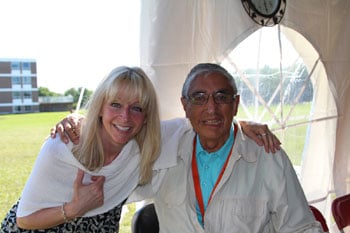This article originally appeared in the Ministry Report, an Anglican Journal supplement produced by the Resources for Mission department. To learn how your gifts support mission, read the full report online now.

Back in the corporate Canada of the 1980s, video emerged as a bold new way to talk to the troops. The Anglican Church of Canada was in the forefront of Canadian Christian denominations when it established its video arm in 1988, under Lisa Barry.
A vibrant component of the church’s Communications and Information Resources Department, Anglican Video has always been committed to capturing the stories out in the field rather than recording them in the studio.
Its first big project was documenting the inaugural Native Convocation (now called Sacred Circle), a national gathering of indigenous and other Anglicans held over two weeks in Fort Qu’Appelle, Sask., in 1988. Video is an optimal fit for working with indigenous people, says Barry, “because First Nations culture is rooted in oral tradition.”
The church’s video arm has also reached out to encourage the participation of Anglicans at large. In 2008’s award-winning Amazing Grace project, for example, it used social media to collect footage of groups across Canada performing the world’s best-known hymn. The project raised more than $100,000 for suicide prevention in northern Canada.
“People were even using their cellphones to send in their versions,” says Barry.
In a similar spirit, 2010’s Silent Night project collected videos of church communities singing renditions of the beloved carol and at the same time raised funds for the military ordinariate.
Another priority is its documentation of the physical and emotional abuse in the Indian residential schools, a testimony that Anglican Video initiated in 1990.
“That has probably been our most groundbreaking work,” says Barry. Her award-winning documentary Topahdewin: The Gladys Cook Story continues to be an important resource work for anti-racism and social work.
Anglican Video’s story has been one of rapid technological change. In the early years, Barry could scarcely lift the bulky cameras of the day and had to hire help.
Now she travels light with digital camcorders and sometimes does the shooting herself. She can edit footage on a laptop anywhere and upload it immediately, instead of sending tapes to Toronto.
Nowhere was this more useful than at the summer 2012 gathering of Sacred Circle. “We were able to immediately edit key moments we wanted to share and get them up on the site the same evening,” says production manager, Becky Boucher.
Barry and Boucher also produce resources for Anglican parishes and individuals, as well as material for broader faith audiences on spiritual topics ranging from baptism and prayer to pilgrimage, prophecy and Bible study.
But their main focus is communicating the Anglican perspective.
“We remain committed to telling the Anglican story to the world,” says Barry. “It’s the most important thing we can do.”
Interested in keeping up-to-date on news, opinion, events and resources from the Anglican Church of Canada? Sign up for our email alerts .
